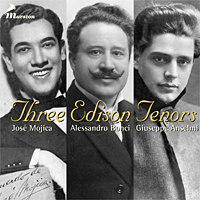
|
Three Edison Tenors Giuseppe Anselmi, Alessandro Bonci, José MojicaLong before Pavarotti, Domingo and Carreras were singing together, Thomas A. Edison was recording three tenors during the early 20th century: Giuseppe Anselmi, Alessandro Bonci, and José Mojica. These tenors never performed together, yet each has left his mark in the history of singing and Edison has preserved their legacies by the most successful recording process of that era. Today, the beauty of Anselmi, the technical prowess of Bonci and the expressiveness of Mojica, is gathered on this one-disc compilation. Their sweet tone and lyricism was captured by Edison at the height of their respective careers resulting in sound that transcends their present fame. These tenors may not be the first three that come to mind, yet after hearing this disc they will not soon be forgotten. |
|
|

Late in 1912, Thomas A. Edison issued his first disc recordings. The Victor and Columbia companies had completely dominated the disc market in the U.S., while Edison had stubbornly clung to the wax cylinder. Finally entering the disc market, he found it necessary to make his product different from any others. He created what he called “diamond discs”, so called because they were to be played using a diamond stylus attached to a floating light weight mechanism. The advantage of this system over others was that the stylus did not need to be changed for each playing of a record, and the floating “reproducer” prevented these discs from wearing out as quickly as those of Edison’s competitors. The new diamond discs were unique, in that they were of a thick laminated construction, making them virtually unbreakable. They were recorded using the “hill and dale” or vertical method which Edison had invented, thereby avoiding patent difficulties with the “lateral” disc recording method employed by Victor and Columbia. At the same time, The Edison Company began manufacturing machines suitable for the play-back of his new creations. In reproducing diamond discs today with modern electrical play-back equipment, most authorities recommended using 3.7 millimeter spherical stylus. I have found, however, that in some instances, a smaller stylus allows more natural overtones of the voice to be reproduced.
The disc recordings made by The Edison Phonograph Company possess the most distinctive sonority of any acoustic records. Once one has become familiar with the sound of Edison’s recordings, any Edison disc is immediately recognizable as such. What is most unique about them is the amazing vividness of the human voice. Edison’s recordings of singers provide the listener with an extremely life-like reproduction of the voice, unrivaled by any other acoustic recordings. How unfortunate it is for posterity that Mr. Edison’s ideas about what constitutes good singing prevented him from capturing more of the great voices of that “golden age”. Perhaps by accident, Edison managed to record many wonderful singers—Lucrezia Bori, Emmy Destinn, Frieda Hempel, Claudia Muzio, Giovanni Zenatello, Jacques Urlus, and the three marvelous tenors heard on this disc. Several of the discs heard here are previously unpublished, and one published disc, Anselmi’s “Spirto gentil” is only known to exist world wide, in three or four copies.
Another distinguishing feature of Edison discs is the sound of the strange orchestration which he personally insisted upon for accompanying his operatic singers. Mr. Edison felt that orchestral accompaniments were of little importance and therefore the orchestration should be as minimal as possible. In accordance with this principle, these recordings give us only the barest outline of the harmonic structure of the accompaniment. This eerie orchestral background is reproduced with the same sonic accuracy as with the voice, which actually serves to detract from the overall superiority of these recordings. In a sense, Edison’s decision to minimize the sound of the orchestra is understandable. For he realized that the state of recording at that time could in no way convincingly recreate the full sound of a symphony orchestra. Would that he had used piano accompaniments instead of the string quartet augmented by an occasional woodwind and the ubiquitous harp.
The third unusual aspect of Edison’s recordings is that he often published two or sometimes even three takes of the same recording. It is not surprising that multiple takes were recorded, but that different takes were often issued simultaneously is completely incomprehensible. In preparing this reissue project, I have had quite a few alternate takes at my disposal. I have chosen in every case the take that I feel is best sung. In the case of Bonci’s recording of “M’apparì tutt’ amor” from Marta, there exists an unpublished take, but I have, for artistic reasons, decided not to use it.
This compact disc, devoted entirely to Edison “diamond disc” recordings, is the first in a projected series which will bring together the most interesting of Edison’s operatic cylinders and discs. Many of these recordings will be heard for the first time in reissue form, and it is hoped that these CDs will not only present to enthusiasts relatively unknown recordings, but will also serve to demonstrate Thomas Edison’s genius for capturing the human voice within the constraints of the acoustic recording process.